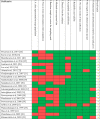Seroprevalence and incidence of hepatitis A in Southeast Asia: A systematic review
- PMID: 34851983
- PMCID: PMC8635355
- DOI: 10.1371/journal.pone.0258659
Seroprevalence and incidence of hepatitis A in Southeast Asia: A systematic review
Abstract
Background: A previous review on hepatitis A virus (HAV) seroprevalence in 2005 categorized Southeast Asia as a low HAV endemicity region. In 2010, the World Health Organization modified this from low to low/medium endemicity, pointing out that these estimates were based on limited evidence. Since then, there has been no attempt to review HAV epidemiology from this region. We conducted a systematic review of literature to collect information on HAV incidence and seroprevalence in select countries in the Southeast Asian region, specifically, The Association of Southeast Asian Nations over the last 20 years.
Methodology: This systematic review was conducted according to the Preferred Reporting Items for Systematic Reviews and Meta-analyses guidelines. From the relevant articles, we extracted data and conducted a risk of bias assessment of individual studies.
Results: The search yielded 22 and 13 publications on HAV seroprevalence and incidence, respectively. Overall, our findings point to a very low HAV endemicity profile in Thailand and Singapore and evidence of a shift towards low HAV endemicity in Indonesia, Lao People's Democratic Republic, Malaysia, the Philippines, and Vietnam. Only Singapore, Thailand, Malaysia, and the Philippines have existing HAV disease surveillance and reported incidence rates below 1 per 100,000. Several outbreaks with varying magnitude documented in the region provide insights into the evolving epidemiology of HAV in the region. Risk of bias assessment of studies revealed that the individual studies were of low to medium risk.
Conclusions/significance: The available HAV endemicity profiles in Southeast Asian countries, aside from Thailand, are limited and outdated, but suggest an endemicity shift in the region that is not fully documented yet. These findings highlight the need to update information on HAV epidemiology through strengthening of disease surveillance mechanisms to confirm the shift in HAV endemicity in the region.
Conflict of interest statement
GHS, DS, KL, PB, ST, AS and SB are employees of the GSK group of companies. GHS and DS hold shares in the GSK group of companies. YP was supported by The Center of Excellence in Clinical Virology, Chulalongkorn University. Authors declare no other financial and non-financial relationships and activities. GlaxoSmithKline Biologicals SA funded this review and all costs associated with its development and publication. All authors had full access to all of the data in this study and take complete responsibility for the integrity of the data and accuracy of the data analysis. We declare that HavrixTM, an inactivated hepatitis A vaccine, is a trademark of the GSK group of companies that is marketed in several countries in Southeast Asia under the scope of this review. There are no additional patents, products in development or marketed products to declare. This does not alter our adherence to PLOS ONE policies on sharing data and materials.
Figures





Similar articles
-
Hepatitis A virus: declining seroprevalence in children and adolescents in Southeast Asia.Southeast Asian J Trop Med Public Health. 1998 Jun;29(2):255-62. Southeast Asian J Trop Med Public Health. 1998. PMID: 9886108 Review.
-
Hepatitis A epidemiology in Latin American countries: a 2020 view from a systematic literature review.Expert Rev Vaccines. 2020 Sep;19(9):795-805. doi: 10.1080/14760584.2020.1813575. Epub 2020 Sep 21. Expert Rev Vaccines. 2020. PMID: 32955965
-
Hepatitis A in the Eastern Mediterranean Region: a comprehensive review.Hum Vaccin Immunother. 2022 Nov 30;18(5):2073146. doi: 10.1080/21645515.2022.2073146. Epub 2022 May 26. Hum Vaccin Immunother. 2022. PMID: 35617508 Free PMC article.
-
A systematic review of the epidemiology of hepatitis A in Africa.BMC Infect Dis. 2019 Jul 22;19(1):651. doi: 10.1186/s12879-019-4235-5. BMC Infect Dis. 2019. PMID: 31331281 Free PMC article.
-
Hepatitis A Virus in Lao People's Democratic Republic: Seroprevalence and Risk Factors.Am J Trop Med Hyg. 2020 Jul;103(1):164-168. doi: 10.4269/ajtmh.19-0451. Epub 2020 Apr 23. Am J Trop Med Hyg. 2020. PMID: 32342836 Free PMC article.
Cited by
-
Seroprevalence and Shifting Endemicities of Hepatitis A Virus Infection in Two Contrasting Geographical Areas in Indonesia.Medicina (Kaunas). 2025 Apr 26;61(5):806. doi: 10.3390/medicina61050806. Medicina (Kaunas). 2025. PMID: 40428764 Free PMC article.
-
Significant Reduction in Seroprevalence of Antibodies Against Hepatitis A across Thailand, 2024.Am J Trop Med Hyg. 2025 Mar 18;112(6):1329-1334. doi: 10.4269/ajtmh.24-0702. Print 2025 Jun 4. Am J Trop Med Hyg. 2025. PMID: 40101293
-
Age-stratified prevalence of anti-hepatitis A virus antibodies in four metropolitan Indian cities and recent changes in Pune city.Indian J Gastroenterol. 2025 Mar 7. doi: 10.1007/s12664-025-01746-y. Online ahead of print. Indian J Gastroenterol. 2025. PMID: 40053056
-
Seroprevalence of hepatitis A virus antibodies among children and adolescents living in Northern Thailand: an implication for hepatitis A immunization.Sci Rep. 2023 Oct 13;13(1):17432. doi: 10.1038/s41598-023-44643-0. Sci Rep. 2023. PMID: 37833325 Free PMC article.
-
Seroprevalence and Shifting Endemicities of Hepatitis A Virus Infection in Two Different Geographical Areas in the Philippines.Infect Dis Ther. 2024 May;13(5):1019-1035. doi: 10.1007/s40121-024-00955-w. Epub 2024 Apr 5. Infect Dis Ther. 2024. PMID: 38578515 Free PMC article.
References
-
- World Health Organization. WHO position paper on hepatitis A vaccines–June 2012. Weekly epidemiological record. 2012;No. 28-29(87):261–76. - PubMed
-
- World Health Organization. WHO immunological basis for immunization series: module 18: hepatitis A. 2019. - PubMed
-
- Centers for Disease Control and Prevention. Hepatitis A. In Epidemiology and Prevention of Vaccine-Preventable Diseases. 13 ed. Hamborsky J KA, Wolfe S, editor. Washington D.C.: Washington D.C. Public Health Foundation; 2015.
Publication types
MeSH terms
LinkOut - more resources
Full Text Sources
Medical

